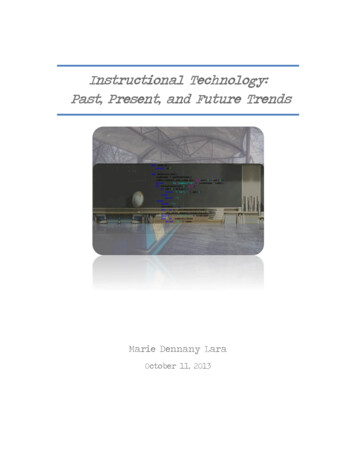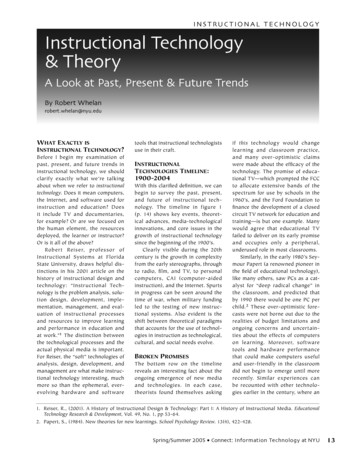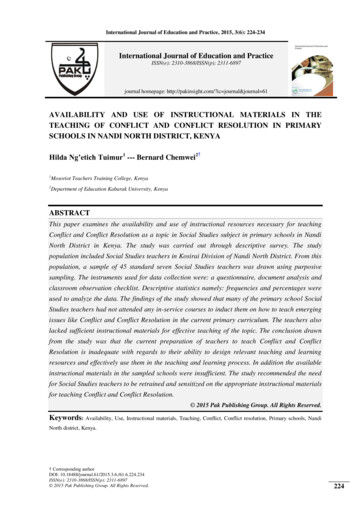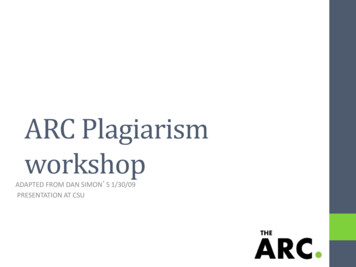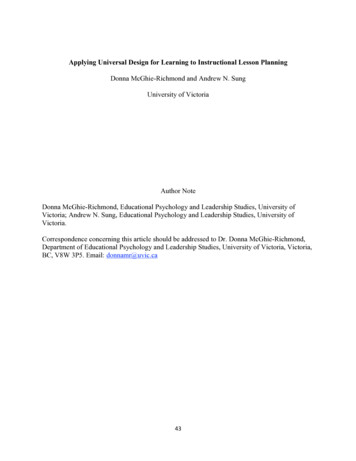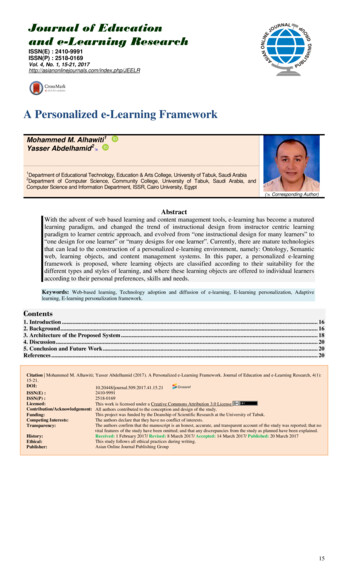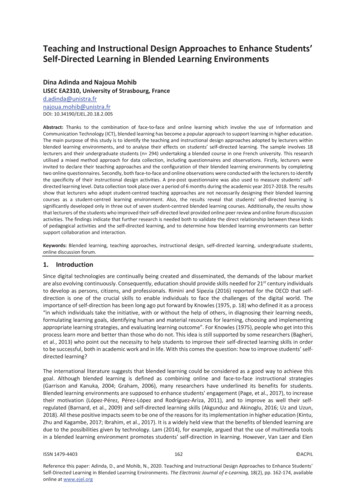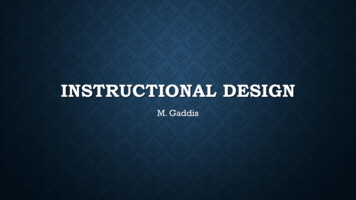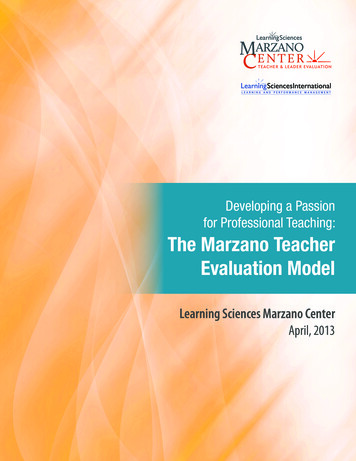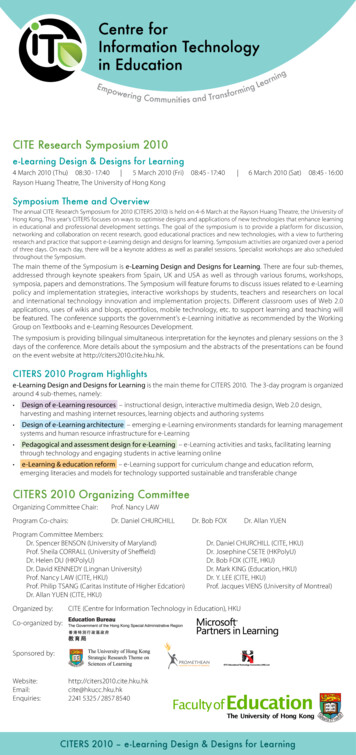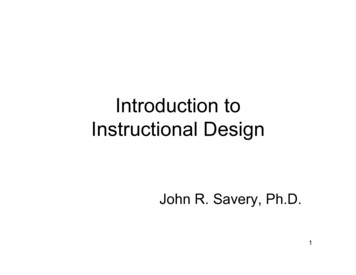
Transcription
Introduction toInstructional DesignJohn R. Savery, Ph.D.1
Remember we are alllearners 2
Learning OutcomesAfter instruction the learner will be able to: Demonstrate knowledge of definitions andvocabulary of instructional design by scoring80% or more on a paper test. Identify and describe the components of theADDIE model. Apply instructional design principles to currentand future instruction including courses withan online component.3
Getting started Instruction is the arrangement ofinformation and environment to facilitatelearning. Learning is the development of newknowledge, skills or attitudes as anindividual interacts with information andthe environment.4
Beware over-simplification! The definition that follows is one of severalequally viable definitions for ID. It is a personal favorite because it works. Avoid simplistic ‘recipe’ approaches. Well designed instruction leading to thoroughlearning is analogous to a well-prepared feastleading to a satisfied palate.5
Definition of InstructionalDesign Instructional design BLENDS what we knowabout ––––the LEARNERSthe SUBJECT MATTERHOW PEOPLE LEARNthe capabilities of an INSTRUCTIONAL MEDIUM to produce instruction that will facilitatelearning6
Expanding on these “Terms” SUBJECT MATTER– The content to be taught including knowledge,skill, or attitude. INSTRUCTION– Ways to organize the subject matter to facilitatelearning (from lecture to virtual reality) DELIVERY– Making the best use of the medium (text, motionvideo, computer-based teaching, etc.)7
Best Practices Ferris Bueller’s Day Off video clip 12 MB media file - use only in classroom Does anyone have a positive examplefrom their teaching that they would liketo share that shows a blend of Subjectmatter, Instruction and Delivery?8
Technology is anything that extends humancapabilities – lever, wheel, chalk board,books, video, computers . Instruction technology refers to both thehardware and the process that is usedto enhance/extend teaching andlearning.9
ID is a “systems” approach. Teaching is about communicatinginformation effectively, nurturinglearners, helping learners to develop Instructional Design is about theorganization of content, sequencing oflearning, assessing achievement, andthe preparation of sound instructionalmaterials so that ‘teaching’ can moveforward.10
A system has four basic parts Input Processing Output Feedback11
System ComponentsINPUTPROCESSINGOUTPUTFEEDBACK12
A Classroom is a ComplexSystem with multiple inputs:–––––––Physical environmentNumber of studentsAbility levels and ages of studentsCurriculum requirementsAvailable teaching resourcesExpectations of students, parents, administrationSkill and knowledge of the teacher13
So what is the ID process? The ID process is a planning andorganizational tool. The process helps to ensure that all theimportant information is considered inthe context of the instructional problemor challenge.14
Components in the ADDIEmodel 5
ID Process - Analysis Front end (feasibility) analysis Mostly corporate concern Learning needs analysis discrepancy or gap analysis (e.g.Kappler) Learner or audience analysis Content or task analysis16
ID Process - Design Specification of intended learningoutcomes knowledge, skills, behaviors, attitudes Specification of evaluation methods andcriteria indicative of learner achievement Scope and sequencing of instructionalevents Media selection17
ID Process - Development Project management Timelines Resource management Prototype development Beta testing Usability testing18
ID Process - Implementation Training for both learners andteachers Embedded help Support materials for successfulutilization Management of resources andtime19
ID Process - Evaluation Formative (short term) beta testing usability testing Summative (long term) large scale validation multiple contexts20
Give time constraintsWe will not examine the nuances of: Implementation Evaluation However, if you chose to work on aproject with Learning Technologies wewill use the entire ID process.21
Instructional Design Models Multiple ID Models - U Denver See also the handout on InstructionalDesign for Online Teaching (availableonline)22
Needs Analysis:Identify the problemthat will be ‘fixed’ byinstruction.Learner Analysis:‘Given’ these learners,what must be consideredto ensure effectiveinstruction?TaskAnalysis:“What” is to belearned?Instructional ProblemEvaluation:Test materialswith learners.Change asindicated.Develop InstructionalMaterials:Attend to the details andmanagement of qualityproduction.Design theInstruction:Blend analysis infowith strategies forteaching, select media,design message.
So what’s the point? Experienced teachers can be spontaneous inthe classroom. after internalizing the teaching/learningprocess and re-teaching the same content Experienced teachers with new subjectmatter need to examine the instructionalprocess. The ID process enhances the creation ofeffective instruction.24
Instructional design is adiscipline Like any other discipline it hasconventions and rules andepistemologies that inform practice. It is not the Holy Grail but it has itsplace in the art and science ofeducation.25
Find a point on the continuumwhere you are comfortable technology rich classroomsextended classrooms (web-based)on-line learning environmentsvirtual classrooms26
Before you take a Break. The next few slides will be a self-test tosee what you recall. Are you ready to begin?27
Questions?After a 5 minutebreak we willexamine the ADDIEmodel in more detail.28
Closer look at ADDIEcomponents Analysis (link) Design (link) Development (link)No time to explore I and E in this class. Implementation (link) Evaluation (link)29
Analysis Consists of at least three components Need for instruction (is instruction thesolution?) Learner analysis Content or Task analysis This is where your eyes start to roll-up inyour head.30
Needs Analysis Less of a problem in Higher Education– Students need the general educationcourse to help them decide on their major– Students need a broad liberal artseducation so all the required Gen Edcourses contribute to a rounded individual Graduate students need the contentknowledge in their chosen discipline31
Learner Analysis "WHO" will be receiving the instruction.Identify important learner characteristics thatmight enhance or impede the instruction. Analyze learners along four domains: cognitive personality social physical32
Cognitive Characteristics: general aptitudes (raw talent)specific aptitudes (mathematic, verbal etc.)functional literacy (e.g., reading level)visual literacy (ability to create and understandimages/graphics) learning styles (Kolb or others) metacognitive abilities (thinking about theirthinking-awareness and self-regulation) prerequisite content knowledge33
Personality Characteristics: Motivation to learn (what drives the learner)Interests (School and non-school)Attitudes toward contentAttitudes toward learningAttitudes toward technologySelf-esteem (Belief that they can succeed)Anxiety (has negative impact on learning)Beliefs/ValuesLocus of control34
Social Characteristics: Tendencies to cooperate or competeRelationships with peersSocioeconomic statusAttitudes toward authorityRacial or ethnic backgroundCultureCareer ambitionsEducational level of family/learner35
Physical Characteristics: Visual abilitiesAuditory abilitiesTactile abilitiesGeneral healthFatigue (energy level, ability tofocus/concentrate) Age Gender36
So What? Many instructors will say: I have a lot of curriculum to cover and notmuch time. I don’t have time to take into considerationthe characteristics of our learners. All of which is true UNLESS an investment oftime and effort to understand your learnerswill impact on teaching and learning.37
How to address learnercharacteristics using a LMS Birds of a Feather discussion forums Buddy systems that match novice studentswith more advanced students Assignments that transfer ‘book’ learning toreal world situations/applications Assignments that support higher orderthinking BUILD ONCE - REUSE OFTEN38
Application Activity Five (5) minutes to discuss with the personsat your table:1. Who are my students (pick a specificcourse)?2. List one learner characteristic from eachcategory that had (or might have) an impacton how you teach.3. One suggestion on how a change in designcould reduce the impact.39
Closer look at ADDIEcomponents Analysis (link) Design (link) Development (link) Implementation Evaluation40
Design - Task Analysis41
Task Analysis Describes in detail "WHAT" theinstruction will focus on – the content. This analysis is reflected in theinstructional objectives. The task analysis is conducted beforethe objectives are written.42
Side note A complete and accurate analysis of the“tasks” facing the learner is the bestinvestment of your time and effort. The “instruction” will frequently fall outof the task analysis so yourdevelopment effort is reduced.43
Make the ‘hidden’ structure of thecontent visible - identify eachelement FactsConceptsPrinciples or RulesProceduresInterpersonal SkillsAttitudes44
Facts Arbitrary labels or terms Necessary to establish a sharedvocabulary with learners Example – English Noun, verb, adverb, adjective Example – Math Denominator, numerator, exponential45
Build aSharedVocabulary46
Concepts Concepts are categories used to groupsimilar ideas Used to simplify and organize Science example Fish – shared characteristics Mammal – shared characteristics Kingdom Phylum Class Order Family Genus Species47
Principles or Rules Describes a relationship betweenconcepts Predictive Gas when heated will expand Physical activity will increase cardiovascular rate Theories Evolution, creationism, alien visitation48
Procedures Ordered sequence of steps Physical steps – hold, turn, release Mental steps – time, observe,measure Ask an expert how they know when astep is needed or completed. What arethe clues/indicators that they look for?49
Interpersonal Skills Verbal and non-verbal skills for effectiveinteractions with others e.g. teacher ‘death stare’ atmisbehavior Warm smiles, eye contact, firm gripetc. Body language50
Attitudes Defined as ‘predispositions’ to behavior Related to values – often unconscious Will probably require careful planningand a lot of time and effort to effectsignificant change to attitudes.51
Procedural Analysis Ask these key questions:What does the learner DO?What does the learner NEED to KNOWto do this step?What cues inform the learner what todo next, if step is completed oralternative required?52
Gathering Task Information Interview an expert (SME) If you are the expert work with someoneto articulate what you know so well Search the literature (training manuals, on-line help,job aides) See what’s already been done that isworthwhile.53
Instructional Strategies drill/rehearsaldidactic lecture s/gamesproject-based learningcase-based learningcollaborative learningproblem-based learning54
Bloom’s Taxonomy The cognitive domain involvesknowledge and the development ofintellectual skills. Use the appropriate verbs to alignexpected learning outcomes with taskswhile moving up the hierarchy fromknowledge to evaluation.55
Learning Theory Behaviorist– stimulus response, reinforcement, programmedlearning, de-contextualized knowledge Cognitivist– information processing model, mind as computer,short term memory, semantic nets Constructivist– knowledge is in the experience, contextualized,social negotiation of meaning, authentic tasks56
Performance ObjectivesDefinition: An objective is a description of a performanceyou want learners to be able to exhibit beforeyou consider them competent. An objective describes an intended result ofinstruction, rather than the process ofinstruction itself. Excerpts from R. F. Mager, (1984) Preparing PerformanceObjectives, Belmont CA: Lake Publishing57
Why care about Objectives?Objectives provide a sound basis for: Selecting or designing instructional materials, contentand procedures Evaluating or assessing the success of the instruction Organizing the students' own efforts and activities forthe accomplishment of important instructional intents. In short, if you know where you are going, you have abetter chance of getting there. The selection of clear, accurate action verbs isimportant.58
Words Open to ManyInterpretationsWords Open to FewInterpretationsTo knowTo understandTo really understandTo writeTo reciteTo appreciateTo fully appreciateTo grasp thesignificance ofTo enjoyTo believeTo have faith inTo internalizeTo identifyTo sortTo solveTo constructTo buildTo compareTo contrastTo smile
Three characteristics. that help make an objective communicate an intent: Performance - always say what a learner isexpected to be able to do; sometimes describes theproduct or result of the doing. Conditions - always describe the importantconditions (if any) under which the performance is tooccur. Criterion - the quality or level of performance that willbe considered acceptable.60
Performance "What is the learner DOING whendemonstrating achievement of theobjective?" Objectives allow for both covert andovert behaviors.61
Conditions The conditions may impact on the performance somust be stated clearly. For example:– Given a problem of the following type – Given a list of – Given any reference of the learner's choice – Given a matrix of intercorrelations – Without the aid of a calculator – While standing knee deep Specify what the learner will and will not be allowedto use when the performance is being assessed.62
Criterion How well? What is the yardstick thatdetermines acceptable performance? Sometimes the criterion are critical to theperformance: sometimes not. Adding a criterion to the objective is a way ofcommunicating an important aspect of what itis you want your students to be able to do. Three Criterion to include: Speed, Accuracy, Quality63
Example of a well writtenperformance objective: Given a compass, ruler, and paper, be able toconstruct and bisect any given angle largerthan five degrees. Bisections must beaccurate to one degree. Clear objectives produce clear assessmentswhich makes the teaching and learning easieron both sides of the equation.64
Closer look at ADDIEcomponents Analysis (link) Design (link) Development (link) Implementation Evaluation65
Design .then Develop Each instructional objective shouldaddress a skill or content as specified inthe task analysis Watch the level of objectives (aim forapplication level once recall etc. are met) Are the appropriate instructionalstrategies matched to each objective?66
Picture the learner As you begin to develop materials, beconsiderate of the cognitive,psychomotor, and emotionaldevelopmental level of the learners. Adjust the reading level and step sizeas required.67
Heuristics for Developers A heuristic is a general rule or “rule ofthumb” Make the instruction “concrete”o Blend text and images (Tufte)68
Step Size and Pacing Break big ideas into smaller bites. Avoid large leaps from one assumptionto another. Pacing refers to the amount of timespend developing understanding. Toofast and too slow extremes to avoid.69
Signaling the Text’s Schema Use an appropriate text structure to signal thelearner about the content: Lists of items or ideas (no significant order) Compare or contrast ideas or objects e.g – difference b/w planet and moon Temporal sequences (over time) Steps in performing a task: start state - end state70
Signaling the Text’s Schema Cause and Effect or Explanations Describe relationships,principles and/or rules Definition and example To teach concepts –characteristics and examples71
Be explicit Use pointer words like – Two methodsfor Use typographical signals like – Headings and sub-headings Layout, including white space toisolate key information Type and format variations – italics,bold, size72
Pictures and Illustrations Visual representation of text messagereinforces learning Use pictures for decoration to catchattention or signal commonalitybetween items Organization – e.g. boxes in a flowchart, steps in a sequence withillustrations or screen captured images73
Stick to basics
Summary Instructional Designers utilize skills andknowledge in the areas of: learning theory the instructional process enabling technologies to facilitate the creation of effectiveinstruction and learning environments75
76
77
78
vocabulary of instructional design by scoring 80% or more on a paper test. Identify and describe the components of the ADDIE model. Apply instructional design principles to current and futur
